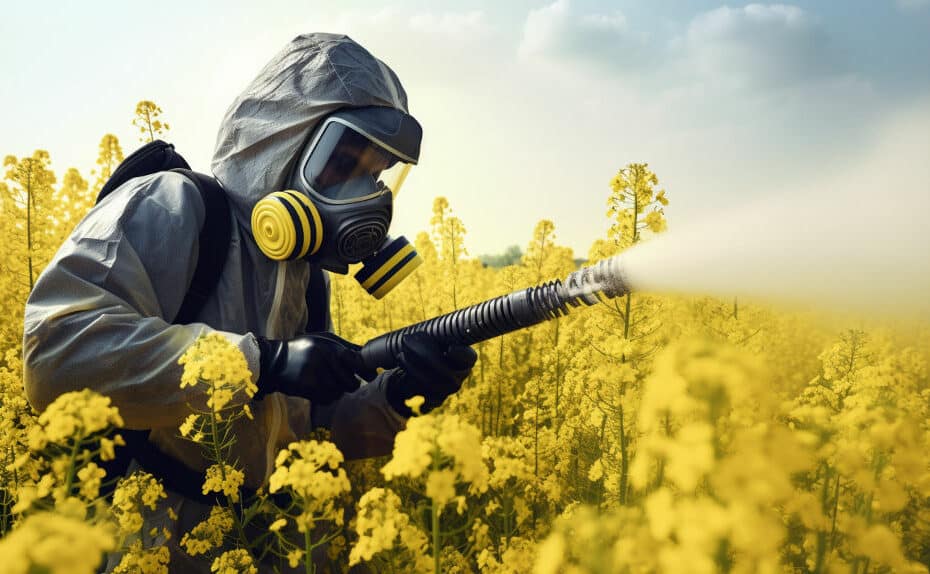Last Updated on July 7, 2024 by Max
Welcome to the Eighth Part of Our Food Safety Series
The pursuit of high-yield crops often necessitates the use of pesticides to guard against detrimental pests. However, the spectrum of pesticides is broad and varied, with some presenting unintended consequences for our environment and biodiversity. Neonicotinoid pesticides stand out, given their association with bee colony collapse (Tomizawa & Casida, 2005).
Neonicotinoids constitute a class of insecticides that target the nervous system of insects, leading to paralysis and eventual death. Their widespread use in agriculture can be attributed to their effectiveness against pests and comparatively low toxicity to mammals (Jeschke et al., 2011).
Studies have demonstrated that Neonicotinoids can severely affect non-target species, especially bees (Woodcock et al., 2017). Bees exposed to Neonicotinoids may experience memory and learning impairments, reduced fertility, and diminished immune function, which can result in the collapse of entire bee colonies (Goulson, 2013).
The gravity of this situation cannot be overstated, as bees play a critical role in pollination, a necessary process for food production and biodiversity preservation (Klein et al., 2007). Thus, bee loss could profoundly affect our ecosystems and food provision.
Recognizing these risks, the European Union has prohibited the outdoor use of three key Neonicotinoids: clothianidin, imidacloprid, and thiamethoxam (European Commission, 2018). However, these pesticides continue to be extensively employed in the U.S., despite growing concerns about their harmful effects on bees (U.S. Environmental Protection Agency, 2020).
The Neonicotinoids’ narrative underscores the differing EU and U.S. strategies regarding food safety and environmental conservation. It also underscores the urgent requirement for sustainable farming practices that secure our food supply while safeguarding biodiversity.
As we further navigate these critical issues, we invite your insights. What are your views on pesticide use and its environmental implications? Have you pondered the pivotal role of bees in our food system?
Conclusion
As we conclude our examination of Azodicarbonamide, we are reminded of the complex challenges in balancing food safety with industrial convenience. The contrasting approaches to food additives regulation in the EU and U.S. highlight the need for informed consumer choices and advocacy for healthier food options. What are your views on the use of such chemicals in food production? How do you prioritize health when it comes to processed foods? We invite you to share your thoughts and join the discussion on this critical topic.
References
- Tomizawa, M., & Casida, J.E. (2005). Neonicotinoid Insecticide Toxicology: Mechanisms of Selective Action. Annual Review of Pharmacology and Toxicology, 45, 247-268.
- Jeschke, P., et al. (2011). Overview of the Status and Global Strategy for Neonicotinoids. Journal of Agricultural and Food Chemistry, 59(7), 2897-2908.
- Woodcock, B.A., et al. (2017). Country-specific Effects of Neonicotinoid Pesticides on Honey Bees and Wild Bees. Science, 356(6345), 1393-1395.
- Goulson, D. (2013). An Overview of the Environmental Risks Posed by Neonicotinoid Insecticides. Journal of Applied Ecology, 50(4), 977-987.
- Klein, A.M., et al. (2007). Importance of Pollinators in Changing Landscapes for World Crops. Proceedings of the Royal Society B: Biological Sciences, 274(1608), 303-313. ↩
- European Commission. (2018). Bee Health: EU Ban on Neonicotinoids Comes into Force. Brussels: European Commission.
- U.S. Environmental Protection Agency (EPA). (2020). EPA’s Actions to Protect Pollinators. Washington, D.C.: EPA.
